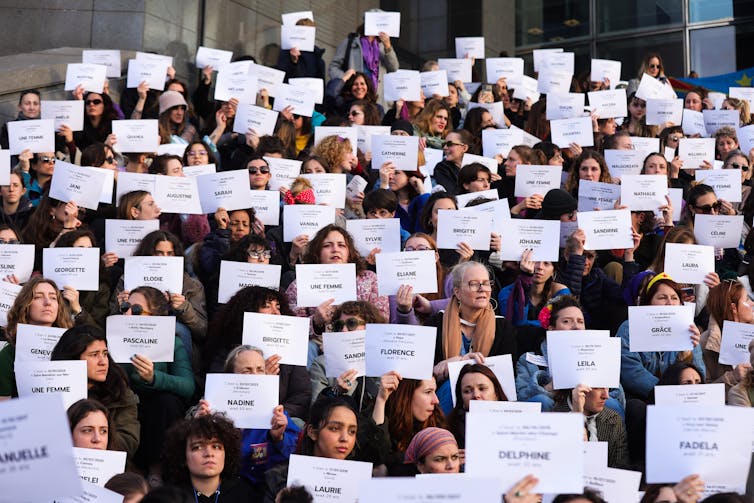An average of five women or girls are killed every hour by someone in their own family, according to UN data. And often their murders are intrinsically linked to them being women. Some countries are now passing laws to specifically criminalise femicide – an extreme manifestation of gender-based violence.
The first documented use of the term “femicide” was in an 1801 book by Irish writer John Corry called A Satirical View of London at the Commencement of the Nineteenth Century where it was used to refer to the killing of a woman. The term was brought back in the 1970s by Diana E.H. Russell, a specialist in violence against women, who worked to highlight the magnitude of male violence and discrimination against women.
While no agreed definition of the phenomenon exists, femicide is broadly defined as the killing of a woman or girl because of her gender. This might be as a result of intimate partner violence or killing in the name of “honour”, for example.
Since the UN adopted resolution 68/191 in 2013, calling for nations to take action against gender-related killing of women and girls, many high-income countries have introduced femicide laws.
In 2022, Cyprus integrated femicide into the criminal code as a distinct crime and rendered gender-related killings an aggravating factor when imposing sentences. That same year, femicide was introduced in Malta’s criminal code. It can now be considered a motivation of the crime of homicide, and in such cases, the judge can consider the highest form of punishment – life imprisonment.

Croatia is the most recent country to adopt a dedicated femicide law, making it a standalone offence punishable with a prison sentence of ten years or more.
Latin America and the Caribbean have some of the highest rates of hate killings of girls and women. In response, 18 of the 33 countries in the region have created new legislation classifying femicide as a distinct hate crime.
Costa Rica became the first country to pass a law making femicide a legally defined crime in 2007. A man who murders his wife or partner can be punished with between 20 and 35 years in prison. There are also specific punishments against physical abuse and restriction of movement, in which a partner manipulates a woman to prevent them from leaving.
Laws are not enough
A report from Queen Mary University of London used the case study of Mexico to argue that the law alone has not led to the reduction of femicide there. The key findings from this report should certainly act as a crucial resource to not only understand the complexity of femicide as an extreme form of gender-based violence but to increase efforts to better respond to it.
One of the main problems is the misclassification of numbers. In many cases, only gender-related killings perpetrated by an intimate partner or family member are counted as femicides.
This leads to under-reporting and invisibility of femicide that happens as part of harmful practices such as female genital mutilation, hate crimes linked to sexual orientation, killing of indigenous women or connections with gangs and other forms of organised crime.
Costa Rica has sought to address this problem by signing into law an extended definition of femicide, which includes femicides perpetuated by those based on a relationship of trust, friendship, authority or power. This is to make it possible to punish crimes against women even if there is no “romantic” relationship between the perpetrator and the victim.
Today, Costa Rica has a lower rate of femicide compared with its neighbours, Guatemala, El Salvador and Mexico.
While the social and political circumstances of countries around the world may differ, there are several lessons in combating femicide that are universal.
The term “feminicide” also carries political connotations. In Latin America it is used to refer to a lack of responsiveness from governments in relation to the killings of women and girls.
The idea of femicide emphasises state culpability and inadequate responses to this gender-based violence. This is particularly noteworthy as the rape and murder of women and girls are commonly used as abominable tools of conflict – this has recently been in evidence in Ukraine, for example.
Given that most femicides are perpetrated by current or former husbands or intimate partners, it is of utmost priority to tackle toxic masculinity and to promote gender equality. Clearly, we need to go beyond the legal framework to combat violence against women and girls. It will take advocacy and active participation of community members to create long-term solutions to curtail femicides.
This article has been amended to remove the popular but incorrect claim that the phrase “rule of thumb” has its origins in an English legal precedent related to domestic abuse.

